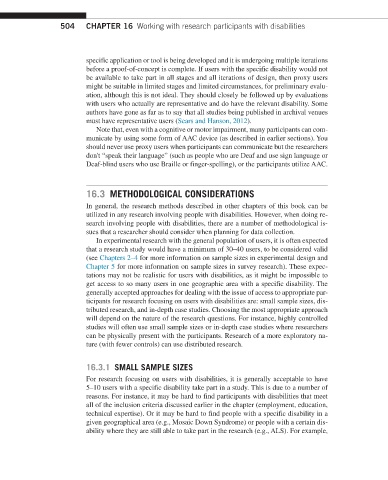Page 511 -
P. 511
504 CHAPTER 16 Working with research participants with disabilities
specific application or tool is being developed and it is undergoing multiple iterations
before a proof-of-concept is complete. If users with the specific disability would not
be available to take part in all stages and all iterations of design, then proxy users
might be suitable in limited stages and limited circumstances, for preliminary evalu-
ation, although this is not ideal. They should closely be followed up by evaluations
with users who actually are representative and do have the relevant disability. Some
authors have gone as far as to say that all studies being published in archival venues
must have representative users (Sears and Hanson, 2012).
Note that, even with a cognitive or motor impairment, many participants can com-
municate by using some form of AAC device (as described in earlier sections). You
should never use proxy users when participants can communicate but the researchers
don't “speak their language” (such as people who are Deaf and use sign language or
Deaf-blind users who use Braille or finger-spelling), or the participants utilize AAC.
16.3 METHODOLOGICAL CONSIDERATIONS
In general, the research methods described in other chapters of this book can be
utilized in any research involving people with disabilities. However, when doing re-
search involving people with disabilities, there are a number of methodological is-
sues that a researcher should consider when planning for data collection.
In experimental research with the general population of users, it is often expected
that a research study would have a minimum of 30–40 users, to be considered valid
(see Chapters 2–4 for more information on sample sizes in experimental design and
Chapter 5 for more information on sample sizes in survey research). These expec-
tations may not be realistic for users with disabilities, as it might be impossible to
get access to so many users in one geographic area with a specific disability. The
generally accepted approaches for dealing with the issue of access to appropriate par-
ticipants for research focusing on users with disabilities are: small sample sizes, dis-
tributed research, and in-depth case studies. Choosing the most appropriate approach
will depend on the nature of the research questions. For instance, highly controlled
studies will often use small sample sizes or in-depth case studies where researchers
can be physically present with the participants. Research of a more exploratory na-
ture (with fewer controls) can use distributed research.
16.3.1 SMALL SAMPLE SIZES
For research focusing on users with disabilities, it is generally acceptable to have
5–10 users with a specific disability take part in a study. This is due to a number of
reasons. For instance, it may be hard to find participants with disabilities that meet
all of the inclusion criteria discussed earlier in the chapter (employment, education,
technical expertise). Or it may be hard to find people with a specific disability in a
given geographical area (e.g., Mosaic Down Syndrome) or people with a certain dis-
ability where they are still able to take part in the research (e.g., ALS). For example,

